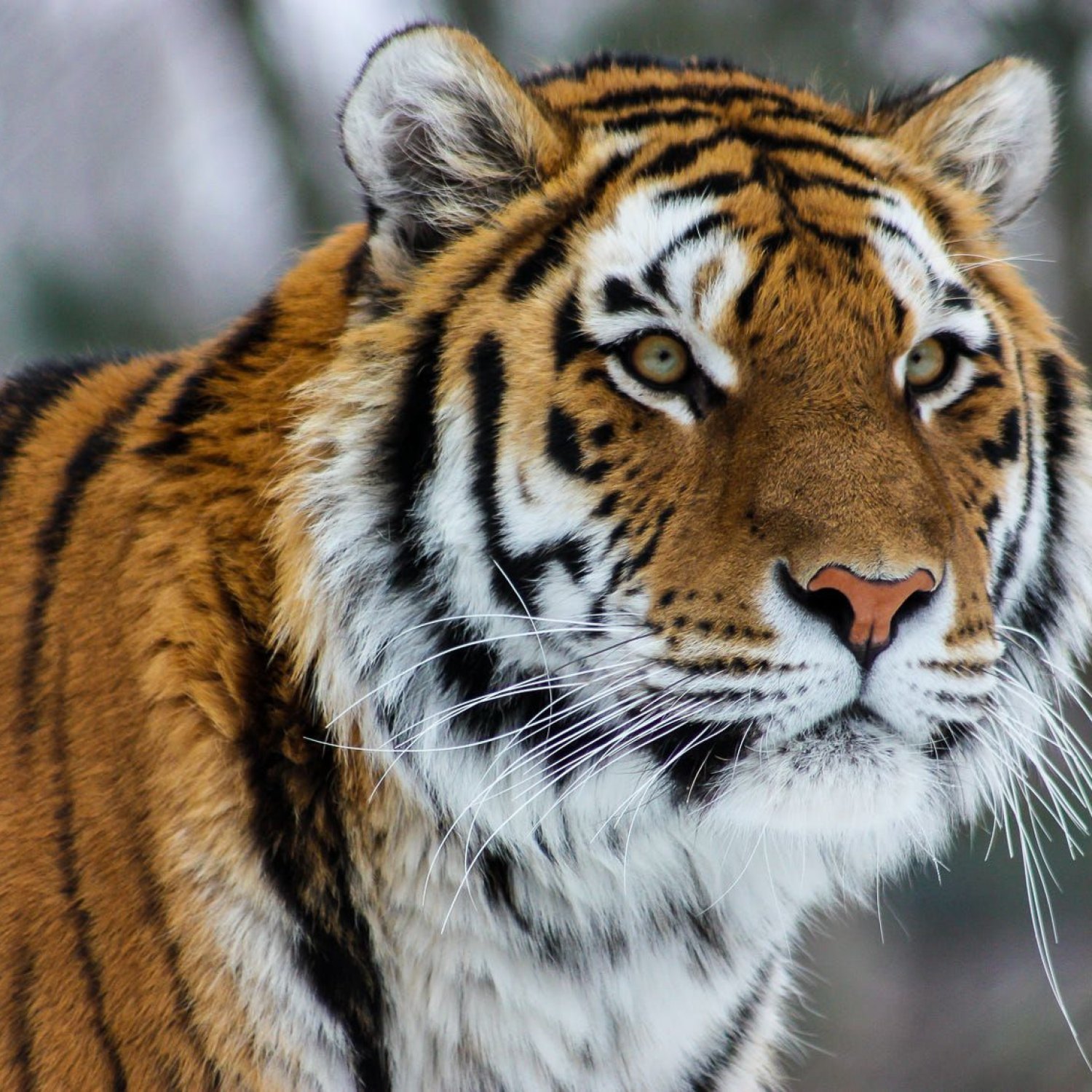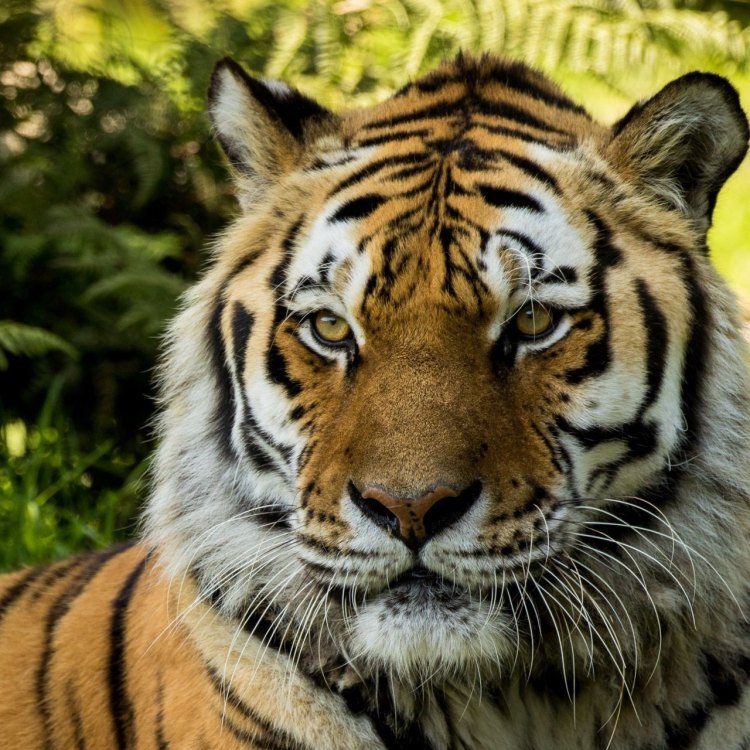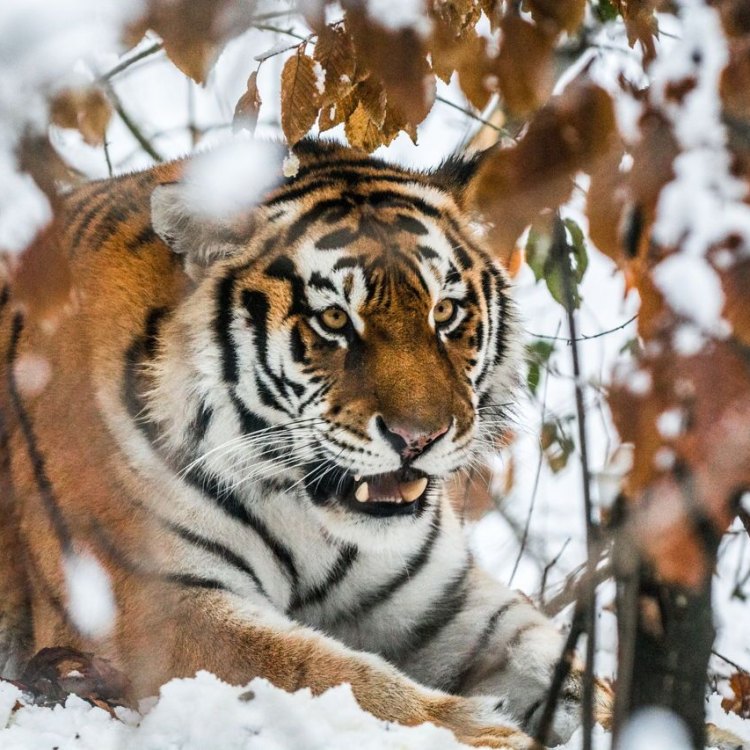
Siberian
10-12 feet (3-3.6 meters)
Meet the majestic Siberian tiger, the largest and most muscular cat in the Felidae family. Reaching lengths of 10-12 feet, these big cats call Siberia their home. Sadly, there are only a few thousand left due to poaching and habitat loss. Let's all do our part to protect these beautiful creatures. #SiberianTiger #AnimalConservation
Animal Details Summary:
Common Name: Siberian Tiger
Kingdom: Animalia
Habitat: Forests, grasslands, taiga, and mountains
The Mythical Beast of Siberia: Exploring the Majestic Siberian Tiger
The Siberian Tiger, also known as the Amur Tiger, is a majestic and elusive creature that roams the vast Siberian forests and mountains. Known for its impressive size, striking appearance, and elusive nature, this feline has captured the hearts and imagination of many people around the world.With its scientific name Panthera tigris altaica, this magnificent creature is a member of the Animalia kingdom, Chordata phylum, Mammalia class, and Carnivora order. In the Felidae family, the Siberian Tiger is one of the largest and most powerful species, and it has earned its place as the crown jewel of the wild cats Siberian.
But what makes the Siberian tiger such an iconic and enigmatic animal? Why is it often referred to as a mythical beast? In this article, we will explore the unique characteristics and features of this magnificent creature and take a closer look at its habitat, behavior, and conservation status.
The Habitat of the Siberian Tiger
Siberian Tigers are mainly found in the dense forests, grasslands, and mountains of eastern Russia, particularly in the region of Siberia. They can also be found in small numbers in China and North Korea.Within Russia, these tigers are found in the Primorsky Krai region, Amur River Basin, and Sikhote-Alin mountain range, which are all located in the Far East of Siberia. This region is known for its harsh and unforgiving climate, with long, cold winters and short, hot summers. Despite these extreme weather conditions, the Siberian Tiger has adapted and thrived in this environment.
Unlike other big cats, the Siberian Tiger is not found in savannas or dense forests. Instead, they prefer to live in open habitats such as the taiga, which is a type of forest dominated by coniferous trees, along with grasslands and scrublands. This habitat provides the tiger with a variety of prey and ample space to roam freely Sockeye Salmon.
Interestingly, the Siberian Tiger is an excellent swimmer and can often be found near bodies of water, such as rivers and streams, where they hunt for fish and other aquatic animals. They are also known to travel to higher elevation areas in search of prey during the winter months when the lower areas are covered in snow.
Feeding Habits and Behavior
Being a carnivorous species, the Siberian Tiger feeds on a diverse array of prey, including elk, deer, wild boar, and even smaller animals such as rodents and fish. They are considered to be the apex predator in their ecosystem and are feared by other animals.What sets the Siberian Tiger apart from other big cats is its impressive hunting abilities. They are solitary hunters and use their large body size and powerful muscles to take down their prey. With a successful hunting rate of 10-20%, these tigers are skilled and efficient predators.
Their striking appearance not only helps them blend into their surroundings for stealthy hunting but also serves as a warning to potential prey. The orange color and black stripes make the Siberian Tiger an easily recognizable and intimidating predator.
Despite their solitary nature, Siberian Tigers can be social animals, with males often forming alliances and roaming their territories together. These alliances are usually formed for hunting and breeding purposes and can last for several years.
Males also play an active role in raising their cubs, a marked contrast to other big cats. They are known to be protective and nurturing towards their offspring, providing them with food and teaching them essential hunting skills.
The Threats to the Siberian Tiger
Despite being a powerful and highly skilled predator, the Siberian Tiger is facing numerous threats that have put it on the brink of extinction. Historically, these animals were hunted extensively for their fur, which is considered a valuable commodity in the fashion industry. This hunting, combined with habitat loss, has resulted in a sharp decline in the number of Siberian Tigers in the wild.It is estimated that there were only about 40 Siberian Tigers left in the 1940s, and today the population has increased to around 500-600 individuals, thanks to conservation efforts. However, this population is still considered critically endangered, and the threats to their survival persist.
One of the major threats to the Siberian Tiger is poaching. Despite being protected by law, these tigers are still hunted for their body parts, which are believed to have medicinal properties in Chinese traditional medicine. Their beautiful fur is also coveted and sold on the black market, making the Siberian Tiger a lucrative target for poachers.
Habitat loss and fragmentation are also major threats to the survival of the Siberian Tiger. Human activities such as logging, mining, and urbanization have resulted in the destruction of their natural habitat. This has not only reduced the available territory for the tigers but has also led to increased human-tiger conflicts as these animals are forced to come into closer contact with humans.
Climate change is another factor that is affecting the Siberian Tiger population. The warming temperatures in their natural range are leading to changes in vegetation and prey availability, forcing these animals to adapt to new conditions. This can be challenging for a species that is already facing numerous threats to its survival.
Conservation Efforts and Success Stories
Thankfully, there has been a significant increase in conservation efforts for the Siberian Tiger in recent years. The Russian government has implemented strict anti-poaching laws and created protected areas to safeguard the habitat of these animals. This has resulted in an increase in the number of Siberian Tigers in the wild.Additionally, there have been successful breeding programs in captivity, with the goal of reintroducing these animals into the wild. Breeding programs have also been set up in other countries, including the United States and China, with the hope of increasing the genetic diversity of the Siberian Tiger population.
These efforts have shown promising results, with the number of Siberian Tigers in the wild gradually increasing. In 2010, it was reported that the number of wild Siberian Tigers had increased to around 540-660 individuals, marking a significant milestone in their conservation.
Final Thoughts
The Siberian Tiger is not just an animal; it is an icon, a mythical beast that has captured the imagination of people for centuries. Its elusive nature, combined with its impressive size and powerful presence, has earned it a place in folklore and pop culture.But beyond its captivating appearance, the Siberian Tiger is a vital part of its ecosystem, playing a crucial role in maintaining the balance of its habitat. It is also a symbol of strength, resilience, and adaptability, qualities that have helped this magnificent animal survive in one of the harshest environments on earth.
While the threats to its survival persist, there is still hope for the Siberian Tiger. With continued conservation efforts and increased awareness, we can ensure that this incredible creature continues to grace the forests and mountains of Siberia for generations to come.

Siberian
Animal Details Siberian - Scientific Name: Panthera tigris altaica
- Category: Animals S
- Scientific Name: Panthera tigris altaica
- Common Name: Siberian Tiger
- Kingdom: Animalia
- Phylum: Chordata
- Class: Mammalia
- Order: Carnivora
- Family: Felidae
- Habitat: Forests, grasslands, taiga, and mountains
- Feeding Method: Carnivorous
- Geographical Distribution: Russia, China, and North Korea
- Country of Origin: Russia
- Location: Siberia
- Animal Coloration: Orange with black stripes
- Body Shape: Large and muscular
- Length: 10-12 feet (3-3.6 meters)

Siberian Tiger
- Adult Size: Males: 400-700 pounds (180-318 kg), Females: 200-350 pounds (90-160 kg)
- Average Lifespan: 10-15 years in the wild, up to 22 years in captivity
- Reproduction: Sexual
- Reproductive Behavior: Mating occurs throughout the year, but peaks in the winter months
- Sound or Call: Roaring, growling, hissing, and chuffing
- Migration Pattern: Non-migratory
- Social Groups: Solitary, but territorial
- Behavior: Siberian tigers are stealthy and intelligent hunters, known for their strength and power
- Threats: Habitat loss, poaching for their fur and body parts, and human-wildlife conflict
- Conservation Status: Endangered
- Impact on Ecosystem: Siberian tigers play a crucial role in maintaining the ecological balance of their environment by regulating prey populations
- Human Use: Siberian tigers are illegally hunted for their fur and body parts, which are highly valued in traditional medicine
- Distinctive Features: Thick fur for surviving in cold climates, white fur on the belly and limbs, and long whiskers
- Interesting Facts: Siberian tigers are the largest subspecies of tigers and can survive in extremely cold climates
- Predator: Siberian tigers have no natural predators

Panthera tigris altaica
The Majestic Siberian Tiger: A Mighty Force of Nature in Peril
The Siberian tiger, also known as the Amur tiger, is the largest subspecies of tiger and a true symbol of power, strength, and beauty. Found in the vast and unforgiving landscapes of Russia's Far East, these magnificent creatures have captured the imaginations of people all over the world.But despite their awe-inspiring presence, the Siberian tiger population is dwindling, and the species is now listed as endangered on the International Union for Conservation of Nature (IUCN) Red List. In this article, we will explore the unique features of the Siberian tiger and the threats that it faces, as well as its crucial role in maintaining the delicate balance of its ecosystem PeaceOfAnimals.Com.
Size and Lifespan
The Siberian tiger is truly a giant among cats, with males averaging 400-700 pounds (180-318 kg) in weight and females around 200-350 pounds (90-160 kg). They also stand out for their impressive size, reaching lengths of up to 10 feet (3 meters) from nose to tail. These tigers have a muscular and stocky build, with broad heads and large paws that are adapted for hunting and navigating through snow-covered terrain.
In the wild, Siberian tigers have an average lifespan of 10-15 years, but in captivity, they can live up to 22 years. Despite their strength and long lifespan, these tigers face numerous threats that have led to their decline.
Reproduction and Reproductive Behavior
Siberian tigers are solitary animals, but they come together to mate, which can occur throughout the year. However, there is a peak in mating activity during the winter months. A female tiger will have a litter of 2-6 cubs after a gestation period of about 3-3.5 months Spotted Garden Eel. These cubs are born blind and completely dependent on their mother for survival.
The cubs will stay with their mother for about two years before venturing out on their own. During that time, the mother teaches the cubs essential hunting and survival skills, preparing them for a life on their own. Female tigers reach sexual maturity at around 4 years, while males take a bit longer, around 5-6 years.
Sound and Call
Siberian tigers may be quiet and elusive creatures, but that doesn't mean they can't make their presence known. These tigers have a variety of vocalizations, including roars, growls, hisses, and chuffs. These sounds are used to communicate with other tigers and to intimidate potential threats.
Migration Pattern and Social Groups
Unlike other subspecies of tigers, the Siberian tiger is non-migratory, meaning it does not have a set pattern of movement throughout the year. Instead, it is adapted to living in the harsh and cold climates of the Russian Far East and remains in its home range for the majority of its life.
Siberian tigers are solitary animals and are highly territorial. A male tiger's territory can range from 60-160 square miles (155-415 square kilometers), while a female's territory is smaller, around 15-40 square miles (40-100 square kilometers). These territorial boundaries are fiercely protected, and conflicts between tigers can often turn violent.
Behavior and Threats
Siberian tigers are apex predators, meaning they are at the top of the food chain and play a crucial role in regulating the populations of their prey. They are stealthy and intelligent hunters, using their size and strength to take down large animals such as deer, boar, and even bears.
Larger prey can sustain a tiger for up to a week, which is why they are solitary and territorial. Without a constant supply of prey, they must defend their territory to ensure their survival. However, their strength and power are no match for the threats they face in today's world.
Habitat loss is one of the most significant threats to the Siberian tiger. As human populations expand, they encroach on the tiger's habitat, leading to fragmentation and destruction of their natural environment. This not only affects the tigers but also their prey, making it difficult for them to find food.
Poaching is another major threat facing the Siberian tiger. They are hunted for their fur and body parts, which are highly valued in traditional medicine. Despite international efforts to curb this illegal trade, poaching continues to be a significant problem, with an estimated 100 tigers killed each year.
Human-wildlife conflict is also a growing threat to the Siberian tiger. As their natural prey becomes scarce, they may turn to domestic animals, such as livestock, for food. This leads to conflicts with local communities, as the loss of livestock can have a severe impact on their livelihoods. In turn, this can result in retaliatory killings of tigers by humans.
Conservation Status and Impact on Ecosystem
The Siberian tiger's population reached a critically low point in the 1940s, with only around 40 individuals remaining in the wild. Thanks to conservation efforts, that number has increased to an estimated 540 in the Russian Far East. However, this is still far below their historical numbers, and the IUCN lists them as endangered.
The decline of the Siberian tiger population has far-reaching consequences for its ecosystem. These tigers play a crucial role in maintaining the ecological balance of their environment. By regulating prey populations, they prevent overgrazing and help maintain healthy and diverse ecosystems. Without them, the entire ecosystem can become imbalanced, affecting everything from the plants to other species of animals.
Human Use and Distinctive Features
Sadly, humans also play a significant role in the decline of the Siberian tiger population. These magnificent creatures are hunted for their fur and body parts, which are illegally traded on the black market. Their thick, striped fur is highly sought after, and their body parts are used in traditional medicine, despite a lack of scientific evidence for their effectiveness.
Siberian tigers' distinctive features include their thick fur, which is adapted for surviving in the harsh and cold climates of Russia's Far East. Their coats are a deep orange with black stripes, and they have white fur on their bellies and limbs, which helps them blend in with the snow.
Another unique feature of these tigers is their long whiskers, which can reach up to 11 inches (28 centimeters) in length. These whiskers help them navigate through their environment, detecting changes in air currents and potential prey.
Interesting Facts
Along with their impressive size and strength, the Siberian tiger has many fascinating characteristics. They are the largest subspecies of tiger and can survive in extremely cold climates, enduring temperatures as low as -50 degrees Fahrenheit (-45 degrees Celsius).
Despite their size, these tigers can move surprisingly silently, thanks to the soft pads on their paws, which dampen the sound of their footsteps. And while they may be solitary animals, they can often be seen engaging in playful behaviors, rolling around in the snow or chasing after each other.
Predators
The Siberian tiger has no natural predators in its environment. However, they do face human threats, as mentioned earlier. In their natural habitat, these tigers are the kings and queens of the Russian Far East, and they play an essential role in maintaining its delicate balance.
In Conclusion
The Siberian tiger is a magnificent and awe-inspiring animal, the largest of all tiger subspecies. Yet, despite its impressive physical abilities, it faces numerous threats and is on the brink of extinction. It is our responsibility, as humans, to take action to protect these creatures and preserve their natural habitat. We must work together to ensure that future generations can also marvel at the majesty of the Siberian tiger and all it represents.

The Mythical Beast of Siberia: Exploring the Majestic Siberian Tiger
Disclaimer: The content provided is for informational purposes only. We cannot guarantee the accuracy of the information on this page 100%. All information provided here may change without prior notice.












